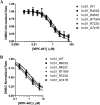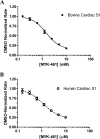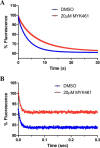A small-molecule modulator of cardiac myosin acts on multiple stages of the myosin chemomechanical cycle
- PMID: 28808052
- PMCID: PMC5633120
- DOI: 10.1074/jbc.M117.776815
A small-molecule modulator of cardiac myosin acts on multiple stages of the myosin chemomechanical cycle
Abstract
Mavacamten, formerly known as MYK-461 is a recently discovered novel small-molecule modulator of cardiac myosin that targets the underlying sarcomere hypercontractility of hypertrophic cardiomyopathy, one of the most prevalent heritable cardiovascular disorders. Studies on isolated cells and muscle fibers as well as intact animals have shown that mavacamten inhibits sarcomere force production, thereby reducing cardiac contractility. Initial mechanistic studies have suggested that mavacamten primarily reduces the steady-state ATPase activity by inhibiting the rate of phosphate release of β-cardiac myosin-S1, but the molecular mechanism of action of mavacamten has not been described. Here we used steady-state and presteady-state kinetic analyses to investigate the mechanism of action of mavacamten. Transient kinetic analyses revealed that mavacamten modulates multiple steps of the myosin chemomechanical cycle. In addition to decreasing the rate-limiting step of the cycle (phosphate release), mavacamten reduced the number of myosin-S1 heads that can interact with the actin thin filament during transition from the weakly to the strongly bound state without affecting the intrinsic rate. Mavacamten also decreased the rate of myosin binding to actin in the ADP-bound state and the ADP-release rate from myosin-S1 alone. We, therefore, conclude that mavacamten acts on multiple stages of the myosin chemomechanical cycle. Although the primary mechanism of mavacamten-mediated inhibition of cardiac myosin is the decrease of phosphate release from β-cardiac myosin-S1, a secondary mechanism decreases the number of actin-binding heads transitioning from the weakly to the strongly bound state, which occurs before phosphate release and may provide an additional method to modulate myosin function.
Keywords: MYK-461; cardiac hypertrophy; cardiomyopathy; myosin; presteady-state kinetics; sarcomere; small molecule.
© 2017 by The American Society for Biochemistry and Molecular Biology, Inc.
Conflict of interest statement
All authors are stockholders of MyoKardia, Inc
Figures










Similar articles
-
Mavacamten stabilizes an autoinhibited state of two-headed cardiac myosin.Proc Natl Acad Sci U S A. 2018 Aug 7;115(32):E7486-E7494. doi: 10.1073/pnas.1720342115. Epub 2018 Jul 17. Proc Natl Acad Sci U S A. 2018. PMID: 30018063 Free PMC article.
-
Synthetic thick filaments: A new avenue for better understanding the myosin super-relaxed state in healthy, diseased, and mavacamten-treated cardiac systems.J Biol Chem. 2021 Jan-Jun;296:100114. doi: 10.1074/jbc.RA120.016506. Epub 2020 Dec 3. J Biol Chem. 2021. PMID: 33234590 Free PMC article.
-
In vitro and in vivo pharmacokinetic characterization of mavacamten, a first-in-class small molecule allosteric modulator of beta cardiac myosin.Xenobiotica. 2019 Jun;49(6):718-733. doi: 10.1080/00498254.2018.1495856. Epub 2018 Oct 1. Xenobiotica. 2019. PMID: 30044681
-
Mavacamten: a novel small molecule modulator of β-cardiac myosin for treatment of hypertrophic cardiomyopathy.Expert Opin Investig Drugs. 2020 Nov;29(11):1171-1178. doi: 10.1080/13543784.2020.1821361. Epub 2020 Sep 20. Expert Opin Investig Drugs. 2020. PMID: 32897741 Review.
-
The role of three-state docking of myosin S1 with actin in force generation.Biophys J. 1995 Apr;68(4 Suppl):194S-199S; discussion 199S-201S. Biophys J. 1995. PMID: 7787067 Free PMC article. Review.
Cited by
-
Safety and Effectiveness of Mavacamten Use in Hypertrophic Obstructive Cardiomyopathy: A Systematic Review and Meta-Analysis.Cureus. 2024 Sep 30;16(9):e70550. doi: 10.7759/cureus.70550. eCollection 2024 Sep. Cureus. 2024. PMID: 39479079 Free PMC article. Review.
-
Cardiac myosin filaments are directly regulated by calcium.J Gen Physiol. 2022 Dec 5;154(12):e202213213. doi: 10.1085/jgp.202213213. Epub 2022 Nov 1. J Gen Physiol. 2022. PMID: 36327149 Free PMC article.
-
Prospects for remodeling the hypertrophic heart with myosin modulators.Front Cardiovasc Med. 2022 Oct 18;9:1051564. doi: 10.3389/fcvm.2022.1051564. eCollection 2022. Front Cardiovasc Med. 2022. PMID: 36330009 Free PMC article. Review.
-
Omecamtiv mecarbil and Mavacamten target the same myosin pocket despite antagonistic effects in heart contraction.bioRxiv [Preprint]. 2023 Nov 15:2023.11.15.567213. doi: 10.1101/2023.11.15.567213. bioRxiv. 2023. Update in: Nat Commun. 2024 Jun 7;15(1):4885. doi: 10.1038/s41467-024-47587-9. PMID: 38014327 Free PMC article. Updated. Preprint.
-
Proof of Principle that Molecular Modeling Followed by a Biophysical Experiment Can Develop Small Molecules that Restore Function to the Cardiac Thin Filament in the Presence of Cardiomyopathic Mutations.ACS Omega. 2019 Apr 30;4(4):6492-6501. doi: 10.1021/acsomega.8b03340. Epub 2019 Apr 9. ACS Omega. 2019. PMID: 31342001 Free PMC article.
References
-
- Maron B. J., Gardin J. M., Flack J. M., Gidding S. S., Kurosaki T. T., and Bild D. E. (1995) Prevalence of hypertrophic cardiomyopathy in a general population of young adults: echocardiographic analysis of 4111 subjects in the CARDIA study. coronary artery risk development in (young) adults. Circulation 92, 785–789 - PubMed
-
- Wilson W. S., Criley J. M., and Ross R. S. (1967) Dynamics of left ventricular emptying in hypertrophic subaortic stenosis: A cinaengiographic and hemodynamic study. Am. Heart J. 73, 4–16 - PubMed
-
- Stewart S., Mason D. T., and Braunwald E. (1968) Impared rate of left ventricular filling in idiopathic hypertrophic subaortic stenosis and valvular aortic stenosis. Circulation 37, 8–14 - PubMed
-
- Ramaraj R. (2008) Hypertrophic cardiomyopathy: etiology, diagnosis, and treatment. Cardiol. Rev. 16, 172–180 - PubMed
-
- Frey N., Luedde M., and Katus H. A. (2011) Mechanisms of disease: hypertrophic cardiomyopathy. Nat. Rev. Cardiol. 9, 91–100 - PubMed
MeSH terms
Substances
LinkOut - more resources
Full Text Sources
Other Literature Sources

